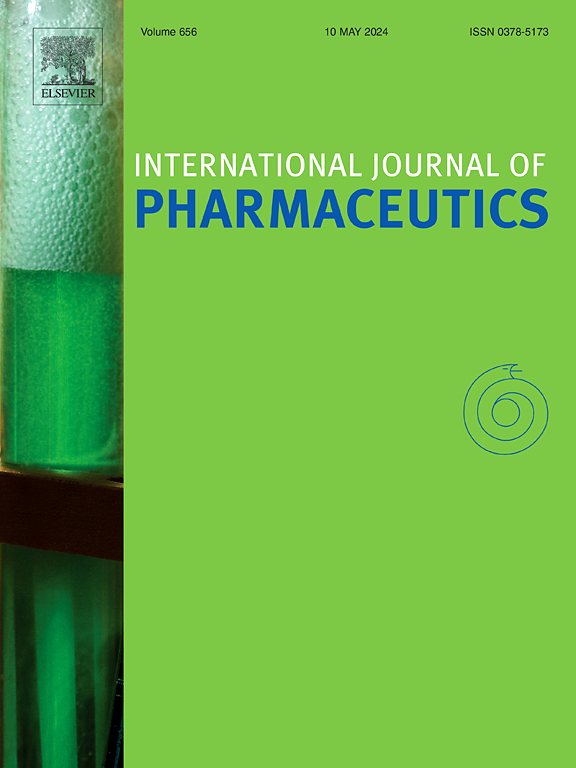壳聚糖凝胶负载碳点和介孔羟基磷灰石纳米颗粒,作为皮肤再生的局部配方:动物实验
IF 5.3
2区 医学
Q1 PHARMACOLOGY & PHARMACY
引用次数: 0
摘要
背景碳点(CD)是抗菌应用领域的研究热点。同时,由于钙离子在皮肤再生中的重要性,人们制备了介孔羟基磷灰石纳米颗粒(mHAP NPs)。本研究旨在同时评估 CD 和 mHAP NPs 的伤口愈合效率。方法我们在 CD 中掺入氟(F)和铜(Cu),制备出 Cu*F 掺杂 CD(Cu.CDs)。为了快速释放钙离子,我们使用了一种新型的双表面活性剂体系(CTAB/F-127)来合成 mHAP NPs。结果一天后,使用 CTAB/F-127 制备的 mHAP NPs 的钙释放量比仅使用 CTAB 制备的高出约 30%。使用 CTAB/F-127 制备的 mHAP NPs 的 BET 比表面积比仅使用 CTAB 制备的 mHAP NPs 高 23.17%。这种高孔隙率提高了伤口渗出物的吸收率。流变学分析表明,同时添加 mHAP NPs 和 Cu.CD 可降低 CTS 凝胶的粘度,从而使其适合局部应用。含有 mHAP + Cu.CDs 的 CTS 凝胶即使在没有光和/或 H2O2 的情况下也具有卓越的抗菌性能,对大肠杆菌和金黄色葡萄球菌的抑制区直径分别为 35 毫米和 17 毫米。含有 mHAP + Cu.CDs 的 CTS 凝胶对全厚皮肤伤口大鼠的伤口闭合效果、炎症抑制效果和上皮再形成效果也明显高于其他组别。本文章由计算机程序翻译,如有差异,请以英文原文为准。
Chitosan gel loaded with carbon dots and mesoporous hydroxyapatite nanoparticles as a topical formulation for skin regeneration: An animal study
Background
Carbon dots (CDs) are the research hotspots in antimicrobial applications. Also, due to the importance of calcium ions in skin regeneration, mesoporous hydroxyapatite nanoparticles (mHAP NPs) were prepared. This study aimed to evaluate the wound healing efficiency of both CD and mHAP NPs simultaneously.
Methods
We doped Fluorine (F) and Copper (Cu) in CDs to prepare Cu*F-doped CDs (Cu.CDs). For the rapid release of calcium ions, a novel double-surfactant system (CTAB/F-127) was used for the synthesis of mHAP NPs. Then, we loaded both Cu.CDs and mHAP NPs simultaneously into the chitosan (CTS) gel.
Results
The released calcium for mHAP NPs prepared using CTAB/F-127 was proved about 30 % higher than that prepared using only CTAB, after one day. The BET-specific surface area for mHAP NPs prepared using CTAB/F-127 was 23.17 % more than that prepared using only CTAB. This high porosity improves wound exudate absorption. Rheological analysis showed that the addition of both mHAP NPs and Cu.CD decreases the viscosity of CTS gel and thereby makes it suitable for topical applications. CTS gel containing mHAP + Cu.CDs indicated exceptional antibacterial properties even without light and/or H2O2 with an inhibition zone diameter of 35 and 17 mm for E. coli and S. aureus species, respectively. CTS gel containing mHAP + Cu.CDs also showed significantly higher wound closure efficacy, greater inflammation inhibition, and better re-epithelialization than the other groups in rats with full-thickness skin wounds.
Conclusion
The CTS gel containing both Cu.CD and mHAP NPs can be proposed as a new therapeutic gel for wound healing.
求助全文
通过发布文献求助,成功后即可免费获取论文全文。
去求助
来源期刊
CiteScore
10.70
自引率
8.60%
发文量
951
审稿时长
72 days
期刊介绍:
The International Journal of Pharmaceutics is the third most cited journal in the "Pharmacy & Pharmacology" category out of 366 journals, being the true home for pharmaceutical scientists concerned with the physical, chemical and biological properties of devices and delivery systems for drugs, vaccines and biologicals, including their design, manufacture and evaluation. This includes evaluation of the properties of drugs, excipients such as surfactants and polymers and novel materials. The journal has special sections on pharmaceutical nanotechnology and personalized medicines, and publishes research papers, reviews, commentaries and letters to the editor as well as special issues.

 求助内容:
求助内容: 应助结果提醒方式:
应助结果提醒方式:


